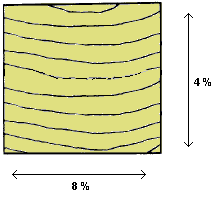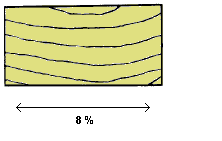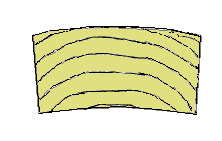Moisture behaviour of wood
Moisture behaviour of wood is the most important property of wood to
understand, to be able to understand how and why wood structures shall be
built the way they shall be built.
Wood swells, because the walls of the cell pipes absorb water and swell.
 |
A good rule of thumb: When bone-dry wood gets soaking wet, it swells 8 %
in the direction of the annular rings (tangentially to the trunk), 4 %
radially to the trunk and not at all lengthwise. And shrinks with the same
percentages when drying through the same moisture scale.
|
These percentages depend on the species, and even the individual, but are
good rules of thumb.
Swelling is different in different directions, because the walls of the
cell pipes are not uniform, but have different thickness in different
directions.
In practice wood is seldom bone-dry nor soaking wet, but something in
between. Hence swelling and shrinking percentages are also something
below the mentioned extremes.
Some examples of wood moisture behaviour
 |
An old wooden kitchen chair seat, 40 cm / 16" wide, has left a
0.8 cm / 1/3" friction mark (red arrow) on the underside. The seat
is glued to the frame only on one side (above in the picture).
Other sides are fastened with clips that allow the seat to swell
and shrink freely. The swelling/shrinking has been about 2 %.
|
 |
The 60 cm / 24" tall panel of an old wooden panel door has swollen/shrunk
by about 1 cm / 1/2", again about 2 %.
The door has been painted blue in the end of the summer (high air
humidity), when the panel has been at it's widest. The picture has
been take in the end of the winter (low air humidity), when the
panel has shrunk to its narrowest. Exposing the old red paint.
|
 |
Measurement of slits in an old wooden floor gives a similar result:
Indoors the annual change in wood dimensions is about 2 %.
This is because of high air humidity in the summer, low in the
winter.
|
A boat is wetted not only by air humidity, but also by the "swimming
element". No conclusions about the amount of swelling can be drawn from
this, however. It's the change in moisture that counts, not the absolute
amount. Wood that always stays soaking wet, stays dimensionally stable.
 |
A tangentially sawn plank can be expected to swell by a maximum of 8 %.
|
 |
Whereas a radially sawn plank would swell only by 4 %. Traditionally
boat planks were sawn like this. It is very unlikely to find radially
sawn lumber in a lumberyard, however. Radial sawing typically produces
less usable lumber out of a given trunk, so it's considered uneconomical
and thus banned.
|
 |
Typical planks are not tangential nor radial, but something in between.
|
 |
In a plank like this there is more "annual ring direction" (more swelling)
on one side than the other.
So when the plank swells, one side swells more than the other, and the plank
curves to a convex cross section.
|
Because of this convexity, a plank that is to be fastened by the edges, should
be fastened heart side facing in.
Similarly, a plank to be fastened only in the middle should be fastened
heart side facing out.
Preface
What is a "wooden boat"?
Structure of wood
Moisture behaviour of wood
Why does a wooden boat leak?
Surface treatment of a wooden boat
The "correct" construction of a wooden boat
Top of the page.
Back to main page.







